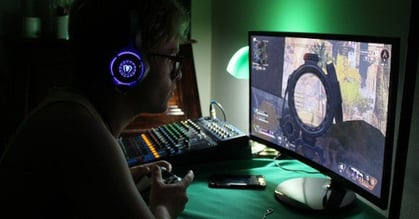Serious games are video games or digital games designed to promote educational content or behaviour changes rather than serving as pure entertainment. They could be a powerful tool to improve treatment adherence in teenagers with a chronic condition.
Type 1 Diabetes is one of the most common metabolic disorders affecting children and adolescents, and its worldwide incidence continues to increase [1]. Despite all the advancements in diabetes treatment, treating teenagers with diabetes type 1 remains a challenge.
Multiple factors such as increased insulin resistance, hormonal changes, changes in body composition and a lifestyle that is less regular (eating and exercise habits) play a role in the worsening of metabolic control during adolescence. The transition of therapy responsibility from parents to their growing children also contributes to a decrease in the frequency of self-testing blood glucose and adherence to therapy after teenagers start self-managing their diabetes. Adherence to treatment is crucial to achieve better therapeutic outcomes, especially when treating chronic diseases. However, adherence rates [2] among patients with chronic conditions tend to be much lower than amongst patients with acute conditions and teenagers need an even higher level of motivation to adhere to their treatment scheme.

How can we promote treatment adherence in teenagers?
Diabetes education is a commonly used tool to help teenagers self-manage their disease. However, knowledge transfer alone does not promote behaviour changes [3], especially in this target group. Teenagers need a high level of motivation to engage in their treatment and achieve good metabolic control.
Diabetes education has to go further than sharing knowledge; it has to empower patients to self-manage their disease [4]. Promoting patient empowerment is crucial to increase treatment adherence of teenagers with T1D, even when they do not experience direct positive effects on their health outcomes. The sum of knowledge, motivation and engagement results in treatment adherence and better health outcomes.
Advancements in diabetes technology – continuous glucose monitoring systems, insulin pens, insulin pumps, artificial pancreas systems, app connectivity, dietary apps, telemedicine monitoring - can increase the adherence of adolescents to their treatment and improve their metabolic control. However, access to modern devices alone does not seem to be enough to motivate and engage teenagers.
Two studies [5, 6] show high discontinuation rates for artificial pancreas among youths with type 1 diabetes. According to these studies, 30% of the youths with type 1 diabetes using an insulin pump, discontinued the system altogether after 6 months. The majority of discontinuation occurred between 3 and 6 months after starting to use it. Among the main reasons for discontinuation were the workload necessary for the proper functioning of the device and the disappointment with glycemic control.
How do we engage teenagers?
So far, there is no straightforward answer. According to self-determination theory [7], it can take up to many months for an external motivation to integrate our daily routine behaviours and it is part of our human nature to fall back into old habits. Hence, it is very important to find ways of keeping patients with chronic diseases continuously motivated.
Being able to self-regulate our behaviour [8] is a necessary skill that helps patients to keep motivated and compliant. It is the ability to control our own behaviour and thoughts to be able, despite the challenges, to keep pursuing our goals. Tools are available that can help to motivate patients, promote behaviour change and self-regulation, and to improve self-management of their disease. Telemedicine portals, digital coaching systems, wearables, health apps, patient web platforms and serious games are some examples.
Serious games are seen as promising tools to help teenagers achieve better treatment adherence, because they can motivate teenagers in an ongoing way. They can combine interactive technologies, artificial intelligence, and educational content with something that teenagers enjoy: gaming. Games have the advantage of engaging people in a way that traditional educational materials cannot. Combined with behavioural theories and following a consumer centre approach, these games can educate adolescents about their disease while promoting positive behaviour change. They offer different possibilities for teenagers to express themselves: they can be designed to provide teenagers with a safe space to experiment, express their own identities, to feel challenged, and be a space where they can create their own rules and have a sense of control and mastering.
In addition, digital technology integrated with serious games makes it easier to replicate, disseminate, store and transmit data, and to personalize experiences. Digital connectivity can be used to integrate games’ behavioural models to personal electronic health records (EHR), helping care providers to better track and evaluate patients’ treatment adherence. Combined with augmented algorithms, it can also provide teenagers and their care providers with alerts and inform of the need of extra interventions. Integrating the game with patients’ health records also enables teenagers to gain points to advance in the game based on their real self-management performance. Besides, it allows for experimentation with different behavioural change models to identify the most suitable model to maximize patients’ health outcomes.
Serious games potential to improve health outcomes
Video games aiming to promote diabetes self-management among children and adolescents is nothing new; some interventions go back to the 90s. Most of the serious games developed so far [9] provide users with decision-making simulations regarding food intake, insulin injections and the relationship between glucose levels, physical activity and food intake.
In recent years, scientific reviews have evaluated serious games’ efficacy in promoting better health outcomes in children and adolescents. Lieberman [10] documented a significant decrease in emergency hospital visits (77%) of teenagers with diabetes using a diabetes game, compared to a control group. The control group received a game without health content. The Daily study [11] showed that combining serious games with BGM readings can promote positive effects on BG level of adolescents with T1D. In this study, a group of children between 8 and 18 years of age received diabetes technology and a motivational game, while the control group just received the technology alone. The participants had to guess a BG level after performing three earlier readings. In a 4-week experiment, compared to the control group, the game group sent significantly more measurements to the platform and had significantly less hyperglycemia, while also showing increase in diabetes knowledge and a better glycemic control. However, a follow-up study showed a decrease in the game use over time, with just 35% still using the app after 12 months.
A user-centred approach was used during a pilot study [12] aiming to design and develop a mobile Health (mHealth) intervention for teenagers with T1D to manage their disease. During the design process, teenagers shared their expectation of having access to technologies that would: (1) allow fast interactions (seconds not minutes), (2) have discrete diabetes content (to avoid being exposed or subject to mockery from peers) and (3) be compatible with their lifestyle. The study performed a 12-week evaluation phase and a group of 20 teenagers received a bant (new developed I-Phone based system) with a reward algorithm and a game like experience. The algorithm gave points for every blood glucose measurement performed and bonus points were given when a full day reading was achieved. When participants would achieve 200 points, they could redeem them by purchasing at Apple iTunes and App stores. An adapter allowed automated data transfer via Bluetooth from One Touch UltraMini to the iPhone. If the participant didn’t have a Bluetooth connection while performing a measurement, the data could be transferred afterwards. Thanks to the analysis tool available, teenagers received feedbacks as soon as data was transferred. The pilot study outcomes showed a 50% increase in blood glucose measurements, when compared to the previous 12 weeks. In addition, 88% of participants were satisfied with the system and would have liked to use it further.
In 2010, Bayer launched another device gamifying blood glucose measurement. DIDGET is a glucose meter that award kids with points that can unlock different levels in 10 different games of the Nintendo DS and DS Lite. Award points are based on frequency, time and results of glucose measuring and users can interact among themselves using an online platform. A study evaluating DIDGET [13] concluded that the device was safe, offered good quality measures and the award scheme motivated users to monitor their glucose levels more often.
Pergamon, a European gamification platform
Building on the potential of serious games, the European Horizon 2020 PERGAMON project developed a gamification platform integrating educational games, real-time monitoring, a virtual coach and personalized motivational feedback. It relied on the combination of a web platform, wearables, mobile apps, digital coaching and serious games to promote educational content and to keep track of BGM, physical activities and food intake. The platform included a main game and several mini games with goals and sub goals with the virtual coach feedback counting to progress on the games. The games were linked to tasks and goals that should be performed in real-life. Users and healthcare givers could set personal goals and exchange messages using the platform and the virtual coach would send motivational messages when the user failed to achieve his goals or follow recommendations.
 The platform was evaluated [14] in a pre-pilot study and in a pilot study and the findings were very similar in both evaluations: most teenagers found the platform not user-friendly, too complex and added too much workload to their lives. In addition, they were annoyed by the quantity of motivational messages they received and lost interest. They were disappointed by the lack of immediate response from the virtual coach after high or low glucose readings and 57% wouldn’t like to frequently use the platform and considered the game too complex for its childish look.
The platform was evaluated [14] in a pre-pilot study and in a pilot study and the findings were very similar in both evaluations: most teenagers found the platform not user-friendly, too complex and added too much workload to their lives. In addition, they were annoyed by the quantity of motivational messages they received and lost interest. They were disappointed by the lack of immediate response from the virtual coach after high or low glucose readings and 57% wouldn’t like to frequently use the platform and considered the game too complex for its childish look.
The researchers believe the outcomes could have been more positive if they had applied a user-centric approach. Involving teenagers during the design of the platform and games could have helped finding a better balance between game look (not too childish) vs. complexity, level of difficulty vs. entertainment and achieved a more user-friendly platform interface.
Conclusion
Adherence to therapy is the biggest challenge of self-managing a chronic disease as it normally involves changing old habits and learning new healthy behaviours. New theoretical models and ideas in the field of diabetes self-management are providing a strong evidence-based foundation of behavioural health principles that could be integrated into the design of future games to more successfully engage and motivate players, improve and support their diabetes self-management, and lead to better health outcomes [15].
When developing serious games and gamified platforms such as PERGAMON, it is key to find the right balance between flawless technologies (to ensure quality) and non-obtrusive technology (to achieve engagement). Last but not least, the design of platforms and games have to be appropriated to the target age group and entertaining enough to keep them engaged. Teenagers are highly motivated if the cognitive skills demanded in a game are compatible with their own cognitive levels [16, 17]. Applying consumer centric and co-design approaches might help achieving the right game appearance and enhance the game entertainment. If the game has a childish look, users might be afraid of mockery and lose interest in it.
Combined with wearables, social media platforms, health apps, telemedicine tools or even integrated to EHRs, serious games can provide a more palatable and entertaining option for teenagers with type 1 diabetes to self-manage their disease and to achieve better health outcomes.
Although studies have shown that serious games can help improving disease self-management [18] by contributing to reduce the frequency of hyperglycemia, optimize glycemic control and decrease the need of hospitalization, follow-up studies are still needed to show if motivation and engagement persist over a long period.
A systematic review of empirical studies on serious games [19] concluded that due to the lack of studies comparing gamified interventions with control groups, there is still a lack of enough scientific evidence to draw a conclusion regarding serious games’ efficacy. Double-blinded randomized controlled trials assessing motivation and health outcomes of serious games, including control groups, adequately powered sample sizes and long-term follow-up assessments of outcomes need to be performed to demonstrate serious games’ efficacy and ensure its wide adoption and long-term success.




